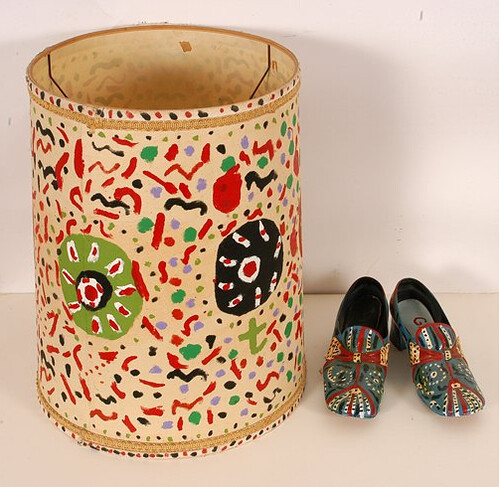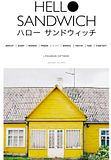Mid-eighteenth century dress from the Metropolitan Museum of Art Costume Institute found at Deborah's wonderful blog KickcanandConkers, who found it via Mothtales, another terrific fantastical site.
It could be argued that the dress above and to a greater extent, the pieces below, fall into the category of folk art. Based on the humbleness of the materials and means used to make them up, and the exuberance and simplicity of their color palettes and execution.
Is it a coincidence, or in some acknowledgement of the recession that has overtaken the developped world, that we are experiencing a "folk art", "handmade", "outsider" moment? If you are judging by the British cultural scene, it's easy to think that. The Victoria and Albert Museum has recently opened a quilts exhibition: Quilts 1700-2010, (see also Barbara's post on this over at BFR Mag) including samples from the museum's collection, art quilts, "important" quilts with historical pedigrees, as well as "homelier" quilts made for common use by "common people". (Thank you Jarvis Cocker.)
It could be argued that the dress above and to a greater extent, the pieces below, fall into the category of folk art. Based on the humbleness of the materials and means used to make them up, and the exuberance and simplicity of their color palettes and execution.
Is it a coincidence, or in some acknowledgement of the recession that has overtaken the developped world, that we are experiencing a "folk art", "handmade", "outsider" moment? If you are judging by the British cultural scene, it's easy to think that. The Victoria and Albert Museum has recently opened a quilts exhibition: Quilts 1700-2010, (see also Barbara's post on this over at BFR Mag) including samples from the museum's collection, art quilts, "important" quilts with historical pedigrees, as well as "homelier" quilts made for common use by "common people". (Thank you Jarvis Cocker.)
via Camilla Engman, at an ambitious project collapsing, Slotins spring auction
In the April 2010 issue of World of Interiors can be found features on James Brett's private collection of mostly American Outsider Art, "The Museum of Everything" Exhibition #1 of which is running at the Pinacoteca Giovanni e Marella Agnelli in Turin, Italy currently through 29 August, 2010. The same issue featured stories about Irene Feesey (yesterday's post) and Mary Delaney, an 18th century "gentlewoman" who, at age 72 devised a "paper mosaik" technique which produced stunning horticultural studies, now on view at Sir John Soanes Museum through May 1, 2010.
The May issue of WOI reviews the new Henry Darger book, (Klaus Biesenbach; Prestel Publishers) an artist who's work fits all the Pale and Interesting, Outsider and "Handmade" descriptions. There is also in the same issue a story on a fabulous, Italian mini/personal museum. It is that of an auto-diact schoolteacher, Ettore Guatelli (Museo Ettore Guatelli, Parma, Italy) which is effectively an old barn and house that over years became filled with Mr. Guatelli's collection of everyday tools and sundry items like clocks and shoe lasts. (Socks! Tin Molds! Wine Baskets! Remind you of anyone you know?!) Much of the tools are displayed on the walls in a way that celebrates their beauty as much as their utility in a manner similar to the way that tools are displayed at the slightly eccentric Barnes Museum in Merion, Pennsylvania.
Which leads to a whole separate discussion about how determinedly a cultured society should be defending, valuing and preserving the particularity of an individual's vision and passion as reflected in their past work and collections. This battle is apparently being lost by Mr. Barnes despite his very specific last will and testament stipulations. His collection has been co-opted by local government, private interests and legatees and looks very likely to be moved from its current location and altered in its management, (contrary to his wishes) in the name of today's "public interest". To find out more about this subject, read the article and see the movie: The Art of the Steal.
Which brings me back to the theme of this series. Interesting and Interestinger!































.jpg)





Brilliant post Mlle Paradis,
ReplyDeleteI was heading out the door... closing down the computer when I just got pulled over to visit you.... those little windows on the bloglists do that!
WOW and WoW! So much to look into...where to start... just a delicious post - love the lamp and shoes. Must be back to investigate... LOVE your take on it all... you are an original MP!
Sophie
oh gorgeous! it looks like one of those outfits from Central Asia. Thanks for all the links. Great post!
ReplyDeleteThat dress is stunning! For a recent photo shoot, I wore a dress that was 100 years old from Yemen, which fit like a glove & was very low cut. And it made me feel beautiful!
ReplyDeleteWow - pleased to see the dress again and Camilla's pic. Lots of interesting links and questions raised here. I need to sit down properly and soak it in. Thank You :)
ReplyDeleteit really is a gorgeous dress, isn't it? and yes, reminds me of bedouin wedding dresses and an afghan dress i bought in london once. and the lampshade reminded me just a bit of kachina doll paintings and african pieces i've seen in the brooklyn museum. i love to see the hand of the maker in a piece.
ReplyDeletecheers ladies!
The dress is so beautiful! I still very much fascinated by the ancient art of design especially the emperor of China's belonging. They are so unique!
ReplyDeleteHave a fabulous day!
Regards, Kristy
curioser and curioser :)
ReplyDeleteYour blog is so like the novel..the more I look..the more wonderful it gets
I will come down here quite often